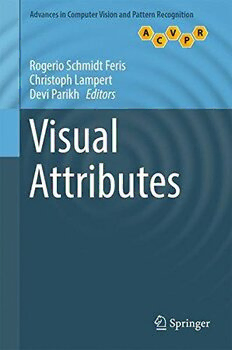
Visual Attributes PDF
Preview Visual Attributes
Advances in Computer Vision and Pattern Recognition Rogerio Schmidt Feris Christoph Lampert Devi Parikh E ditors Visual Attributes Advances in Computer Vision and Pattern Recognition Founding editor Sameer Singh, Rail Vision, Castle Donington, UK Series editor Sing Bing Kang, Microsoft Research, Redmond, WA, USA Advisory Board Horst Bischof, Graz University of Technology, Austria Richard Bowden, University of Surrey, Guildford, UK Sven Dickinson, University of Toronto, ON, Canada Jiaya Jia, The Chinese University of Hong Kong, Hong Kong Kyoung Mu Lee, Seoul National University, South Korea Yoichi Sato, The University of Tokyo, Japan Bernt Schiele, Max Planck Institute for Computer Science, Saarbrücken, Germany Stan Sclaroff, Boston University, MA, USA More information about this series at http://www.springer.com/series/4205 Rogerio Schmidt Feris Christoph Lampert (cid:129) Devi Parikh Editors Visual Attributes 123 Editors RogerioSchmidt Feris DeviParikh IBMT.J.Watson Research Center Georgia Tech Yorktown Heights, NY Atlanta, GA USA USA Christoph Lampert Computer Vision andMachine Learning IST Austria Klosterneuburg Austria ISSN 2191-6586 ISSN 2191-6594 (electronic) Advances in Computer Vision andPattern Recognition ISBN978-3-319-50075-1 ISBN978-3-319-50077-5 (eBook) DOI 10.1007/978-3-319-50077-5 LibraryofCongressControlNumber:2016958717 ©SpringerInternationalPublishingAG2017 Thisworkissubjecttocopyright.AllrightsarereservedbythePublisher,whetherthewholeorpart of the material is concerned, specifically the rights of translation, reprinting, reuse of illustrations, recitation, broadcasting, reproduction on microfilms or in any other physical way, and transmission orinformationstorageandretrieval,electronicadaptation,computersoftware,orbysimilarordissimilar methodologynowknownorhereafterdeveloped. The use of general descriptive names, registered names, trademarks, service marks, etc. in this publicationdoesnotimply,evenintheabsenceofaspecificstatement,thatsuchnamesareexemptfrom therelevantprotectivelawsandregulationsandthereforefreeforgeneraluse. The publisher, the authors and the editors are safe to assume that the advice and information in this book are believed to be true and accurate at the date of publication. Neither the publisher nor the authorsortheeditorsgiveawarranty,expressorimplied,withrespecttothematerialcontainedhereinor foranyerrorsoromissionsthatmayhavebeenmade. Printedonacid-freepaper ThisSpringerimprintispublishedbySpringerNature TheregisteredcompanyisSpringerInternationalPublishingAG Theregisteredcompanyaddressis:Gewerbestrasse11,6330Cham,Switzerland Preface Visual attributes are generally defined as mid-level semantic visual concepts or properties that are shared across categories, e.g., furry, striped, metallic, young. They have recently gained significant popularity in computer vision, finding applications in zero-shot classification (where a machine can recognize a concept even without having seen it before), image ranking and retrieval, fine-grained categorization, human–machine interaction, and many others. Thisbookprovidesanoverviewofandsummarizesrecentadvancesinmachine learning and computer vision related to visual attributes, while exploring the intersection with other disciplines such as computational linguistics and human– machineinteraction.Itcontainsacollectionofchapterswrittenbyworld-renowned scientists, covering theoretical aspects of visual attribute learning as well as prac- tical computer vision applications. Wewouldliketoexpressoursinceregratitudetoallchaptercontributorsfortheir dedicationandhigh-qualitywork,aswellastoSimonReesandWayneWheelerfrom Springerfortheirsupportandhelpthroughoutthebook’spreparation. Yorktown Heights, NY, USA Rogerio Schmidt Feris Vienna, Austria Christoph Lampert Atlanta, GA, USA Devi Parikh September 2016 v Contents 1 Introduction to Visual Attributes... .... .... .... .... ..... .... 1 Rogerio Schmidt Feris, Christoph Lampert and Devi Parikh Part I Attribute-Based Recognition 2 An Embarrassingly Simple Approach to Zero-Shot Learning. .... 11 Bernardino Romera-Paredes and Philip H. S. Torr 3 In the Era of Deep Convolutional Features: Are Attributes Still Useful Privileged Data?.. ..... .... .... .... .... .... ..... .... 31 Viktoriia Sharmanska and Novi Quadrianto 4 Divide, Share, and Conquer: Multi-task Attribute Learning with Selective Sharing... ..... .... .... .... .... .... ..... .... 49 Chao-Yeh Chen, Dinesh Jayaraman, Fei Sha and Kristen Grauman Part II Relative Attributes and Their Application to Image Search 5 Attributes for Image Retrieval. .... .... .... .... .... ..... .... 89 Adriana Kovashka and Kristen Grauman 6 Fine-Grained Comparisons with Attributes... .... .... ..... .... 119 Aron Yu and Kristen Grauman 7 Localizing and Visualizing Relative Attributes .... .... ..... .... 155 Fanyi Xiao and Yong Jae Lee Part III Describing People Based on Attributes 8 Deep Learning Face Attributes for Detection and Alignment . .... 181 Chen Change Loy, Ping Luo and Chen Huang 9 Visual Attributes for Fashion Analytics.. .... .... .... ..... .... 215 Si Liu, Lisa M. Brown, Qiang Chen, Junshi Huang, Luoqi Liu and Shuicheng Yan vii viii Contents Part IV Defining a Vocabulary of Attributes 10 A Taxonomy of Part and Attribute Discovery Techniques.... .... 247 Subhransu Maji 11 The SUN Attribute Database: Organizing Scenes by Affordances, Materials, and Layout .. .... .... .... ..... .... 269 Genevieve Patterson and James Hays Part V Attributes and Language 12 Attributes as Semantic Units Between Natural Language and Visual Recognition.. ..... .... .... .... .... .... ..... .... 301 Marcus Rohrbach 13 Grounding the Meaning of Words with Visual Attributes.... .... 331 Carina Silberer Index .... .... .... .... .... ..... .... .... .... .... .... ..... .... 363 Chapter 1 Introduction to Visual Attributes RogerioSchmidtFeris,ChristophLampertandDeviParikh Visualrecognitionhassignificantlyadvancedinrecentyears,particularlythroughthe widespreadadoptionofdeepconvolutionalneuralnetworks[22,28]asthemaintool forsolvingcomputervisionproblems.Therecognitionaccuracyrecentlyobtainedin standardbenchmarkdatasets,suchasImagenet[7],hasevensurpassedhuman-level performance[15]. Thefueltopoweruptheseneuralnetworkmodelsistrainingdata.Infact,current methods often require at least thousands of manually annotated training examples forlearningrobustclassifiersfornewcategories.Whileitiseasytoobtainalarge number of example images for common categories, such as images of vehicles or dogs,itisnotstraightforwardtoobtainannotatedtrainingsetsforotherinfrequent categories,suchasaparticularvehiclemodeloraspecificdogbreed.Therearetens of thousands of basic categories in the world (and significantly more subordinate categories)[3].Formanyofthem,onlyafewornoexamplesatallareavailable. Zero-data or zero-shot classification refers to the problem of recognizing cate- goriesforwhichnotrainingexamplesareavailable[26, 30].Thisproblemhappens inmanypracticalsettings.Asanexample,forthetaskofpredictingconcretenouns from neural imaging data [30], many nouns may not have corresponding neural imageexamplesbecauseofthecostlylabelacquisitionprocess.Inthevisualsurveil- lancedomain,whileconductingacriminalinvestigation,thepolicemayhaveonly B R.S.Feris( ) IBMT.J.WatsonResearchCenter,NewYork,USA e-mail:[email protected] C.Lampert InstituteofScienceandTechnologyAustria,Klosterneuburg,Austria e-mail:[email protected] D.Parikh GeorgiaTech,Atlanta,GA,USA e-mail:[email protected] ©SpringerInternationalPublishingAG2017 1 R.S.Ferisetal.(eds.),VisualAttributes,AdvancesinComputerVision andPatternRecognition,DOI10.1007/978-3-319-50077-5_1 2 R.S.Ferisetal. eyewitnessdescriptionsavailableforsearchingatargetedsuspect,insteadofexam- pleimages[13, 40].Manyfine-grainedvisualcategorizationtaskshaveclassesfor whichonlyafewornotrainingimagesexist.Forinstance,theImageNetdatasethas 30mushroomsynsets,eachwith1000images,whereastherearemorethantenthou- sandmushroomspeciesfoundinnature.Thezero-shotclassificationproblemisalso commoninotherfields.Inlargevocabularyspeechrecognitionsystems,itisinfea- sibletoacquiretrainingsamplesforeachword.Recommendersystemsfaceissues whennewappsarereleasedwithoutanyuserratings(alsoknownasthecold-start problem[35]). Visualattributes,whicharegenerallydefinedasmid-levelsemanticpropertiesthat are shared across categories (e.g., furry, yellow, four-legged), provide an effective way of solving the zero-shot classification problem. As initially demonstrated by Lampert et al. [25, 26], a novel unseen category with an associated description based on semantic attributes (either provided by experts or mined from language sources,suchasWikipedia[33,34])canberecognizedbyleveragingvisualattribute classifiers,whichcanbelearnedusingexistingtrainingdatafromknowncategories. Thisprocessisalignedwithhumancapabilitiesofidentifyingobjectsonlybasedon descriptions.Forexample,whengivenasentencelike“largegrayanimalswithlong trunks,” we can reliably identify elephants [26]. Currently, the highest-performing methodsforzero-shotlearningrelyonvisualattributes,ofteninconnectionwithother formsofsemanticembeddingsuchasdistributionalwordvectorrepresentations[1, 2, 14, 33]. Visualattributesarebothsemantic(human-understandable)andvisual(machine- detectable).Inadditiontozero-shotlearning,theyhaveproveneffectiveinvarious other applications. As a communication channel between humans and machines, attributeshavebeenusedforinteractiverecognitionoffine-grainedcategories[4], active learning [21], and image search with humans in the loop [20]. Attributes discretize a high dimensional feature space into a simple and readily interpretable representation that can be used to explain machine decisions to humans [16] and predictuserannoyance[5].Conversely,humanscanproviderationalestomachines as a stronger form of supervision through visual attributes [10]. Along this direc- tion, attributes can serve as a form of privileged information [36] for improving recognition,especiallywhenonlyafewtrainingexamplesareavailable. Anotherareainwhichattributeshaverecentlyplayedamajorroleisvisualanalysis ofpeople.Inthevisualsurveillancedomain,state-of-the-artpersonreidentification systems[27,37,39]benefitfromhumanattributesasfeaturesforimprovingmatch- ingofpeopleacrosscameras.Theextractionoffaceandclothingattributesenable searchforsuspectsormissingpeoplebasedontheirphysicaldescription[13,40].In e-commerceapplications,attributesareveryeffectiveinimprovingclothingretrieval [17]andfashionrecommendation[29].Ithasalsobeenshownthatfacialattribute predictionishelpfulasanauxiliarytaskforimprovingfacedetection[42]andface alignment[43].Methodsforimagerankingandretrievalalsobenefitfromattributes asacompactandsemanticimagerepresentation[11, 23, 38]. Otherapplicationsofvisualattributesincludedescribingunfamiliarobjects[12], scene analysis [32], material classification [6], and image virality prediction [8].
